Sanyo CE22LD90DV Instruction Manual
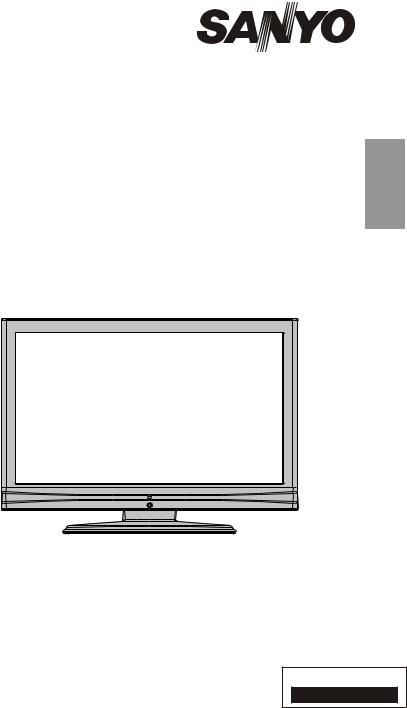
INSTRUCTION MANUAL
Colour television
CE22LD90DV-B
ENGLISH |
1 - 63 |
Problems with set-up?
Please read this Instruction book before using your television.
Call 0870 240 7475
We wish you many hours of pleasure from your new television.

Contents |
|
Features ................................................................. |
3 |
Introduction............................................................. |
4 |
Preparation............................................................. |
4 |
Safety Precautions ................................................. |
4 |
Power Source ..................................................... |
4 |
Power Cord......................................................... |
4 |
Moisture and Water ............................................ |
4 |
Cleaning.............................................................. |
4 |
Heat and Flames ................................................ |
4 |
Lightning ............................................................. |
4 |
Replacement Parts ............................................. |
4 |
Servicing............................................................. |
5 |
Waste Disposal................................................... |
5 |
FOR EU USERS................................................. |
5 |
Disconnecting the Device ................................... |
5 |
Headphone Volume ............................................ |
5 |
Installation........................................................... |
5 |
LCD Screen ........................................................ |
5 |
Warning .............................................................. |
5 |
Overview of the Remote Control ............................ |
6 |
LCD TV and Operating Buttons.............................. |
7 |
Viewing the ConnectionsBack Connectors .......... |
8 |
Aerial Connection .................................................. |
11 |
Anti-theft Protection ........................................... |
11 |
Inserting Batteries in the Remote Control |
|
Handset ................................................................ |
17 |
Operating Range for the Remote Control............. |
17 |
Switching the TV On/Off ....................................... |
17 |
To Switch the TV On ......................................... |
17 |
To Switch the TV Off ......................................... |
17 |
Input Selection...................................................... |
17 |
Basic Operations .................................................. |
18 |
Operation with the Buttons on the TV............... |
18 |
Volume Setting.............................................. |
18 |
Programme Selection ................................... |
18 |
Viewing Main Menu....................................... |
18 |
AV Mode ....................................................... |
18 |
Operation with the Remote Control .................. |
18 |
Volume Setting.............................................. |
18 |
Programme Selection (Previous or Next |
|
Programme).................................................. |
18 |
Programme Selection (Direct Access) .......... |
18 |
General Operation................................................ |
20 |
Information Banner ........................................... |
20 |
Displaying Subtitles .......................................... |
21 |
Digital Teletext (** for UK only) ......................... |
21 |
Analogue Teletext ............................................. |
21 |
Widescreen....................................................... |
21 |
Channel List...................................................... |
22 |
Navigating the Entire Channel List ............... |
22 |
Moving the channels in the channel list ........ |
22 |
Deleting the Channels in the Channel List.... |
22 |
Renaming Channels ..................................... |
23 |
Adding Locks to Channels ............................ |
23 |
Setting Favourites......................................... |
23 |
How to Add a Channel to a Favourites |
|
List.......................................................... |
24 |
Removing a Channel from Favourite List24 |
|
On Screen Help ..................................... |
24 |
Program Guide ............................................. |
24 |
Timers............................................................... |
24 |
Conditional Access ........................................... |
24 |
TV Setup........................................................... |
25 |
Setup ................................................................ |
25 |
Configuration ................................................ |
25 |
AC3 Audio (* for EU countries only) ....... |
25 |
Hard of Hearing (* for EU countries only)25 |
|
Favourite Mode....................................... |
26 |
Channel List ........................................... |
26 |
Active Antenna ....................................... |
26 |
Scan Encrypted (**)................................ |
26 |
Receiver Upgrade .................................. |
26 |
Over Air Download (OAD) ...................... |
26 |
Parental Control ..................................... |
26 |
Maturity Lock (*)................................... |
27 |
Menu Lock ........................................... |
27 |
Set PIN................................................. |
27 |
Time Settings ................................................ |
27 |
Audio Description (Optional)......................... |
27 |
Audio Description (Optional) .................. |
27 |
Preferred Language (Optional)............... |
27 |
Relative Volume (Optional)..................... |
27 |
Standby Search (*) ....................................... |
28 |
Language...................................................... |
28 |
Preferred................................................. |
28 |
Current.................................................... |
28 |
Language Settings ................................. |
28 |
Installation..................................................... |
28 |
Automatic Channel Scan........................ |
29 |
Manual Channel Scan ............................ |
29 |
Clear Service List (*)............................... |
29 |
First Time Installation.............................. |
29 |
Analogue TV Menu System.................................. |
31 |
Picture Menu..................................................... |
31 |
Mode............................................................. |
31 |
Brightness/Contrast/Colour/Sharpness/Hue. 31 |
|
Colour Temp.................................................. |
31 |
Noise Reduction ........................................... |
31 |
Film Mode ..................................................... |
31 |
Game Mode (optional) .................................. |
31 |
Picture Zoom ................................................ |
32 |
Store ............................................................. |
32 |
Reset ............................................................ |
32 |
Sound Menu ................................................. |
32 |
Volume.......................................................... |
32 |
Equalizer....................................................... |
32 |
Balance......................................................... |
32 |
Headphone ................................................... |
32 |
English - 1 -

Volume.................................................... |
32 |
Sound Mode ................................................. |
33 |
AVL ......................................................... |
33 |
Spdif Out....................................................... |
33 |
Effect............................................................. |
33 |
Store ............................................................. |
33 |
Feature Menu ................................................... |
33 |
Sleep Timer................................................... |
33 |
Child Lock ..................................................... |
33 |
Language...................................................... |
33 |
Default Zoom ................................................ |
33 |
Blue Background .......................................... |
33 |
Menu Background......................................... |
33 |
Backlight ....................................................... |
33 |
Menu Timeout ............................................... |
34 |
Teletext Language ........................................ |
34 |
Ext Out.......................................................... |
34 |
HDMI PC Full Mode...................................... |
34 |
Install Menu ...................................................... |
34 |
Program ........................................................ |
34 |
Band ............................................................. |
34 |
Channel ........................................................ |
34 |
Colour System .............................................. |
34 |
Sound System .............................................. |
34 |
Fine Tune...................................................... |
34 |
Search .......................................................... |
34 |
Store ............................................................. |
34 |
Install Menu in AV Modes.............................. |
34 |
Colour System........................................ |
35 |
Store ............................................................. |
35 |
Program Table............................................... |
35 |
Name...................................................... |
35 |
Move....................................................... |
35 |
Delete ..................................................... |
35 |
APS (Auto Programming System).......... |
35 |
Country................................................... |
35 |
Source Menu .................................................... |
35 |
PC Mode Menu System........................................ |
36 |
PC Position Menu............................................. |
36 |
Autoposition .................................................. |
36 |
H (Horizontal) Position.................................. |
36 |
V (Vertical) Position ...................................... |
36 |
Phase............................................................ |
36 |
Dot Clock ...................................................... |
36 |
PC Picture Menu........................................... |
36 |
Sound Menu ................................................. |
37 |
Feature Menu ............................................... |
37 |
Source Menu ................................................ |
37 |
Displaying TV Information .................................... |
37 |
Mute Function....................................................... |
37 |
Picture Mode Selection......................................... |
37 |
Freezing Picture ................................................... |
37 |
Zoom Modes......................................................... |
37 |
Auto .................................................................. |
37 |
16:9................................................................... |
37 |
4:3..................................................................... |
37 |
Panoramic......................................................... |
37 |
14:9................................................................... |
38 |
Cinema ............................................................. |
38 |
Subtitle.............................................................. |
38 |
Zoom................................................................. |
38 |
Teletext ................................................................. |
38 |
Screen Care...................................................... |
39 |
Image Persistence............................................ |
39 |
No Power.......................................................... |
39 |
Poor Picture...................................................... |
39 |
No Picture......................................................... |
39 |
Sound ............................................................... |
39 |
Remote Control................................................. |
39 |
Input Sources.................................................... |
39 |
Appendix A: PC Input Typical Display Modes....... |
40 |
Appendix B: AV and HDMI Signal Compatibility |
|
(Input Signal Types).............................................. |
41 |
Appendix C: Pin Specifications............................. |
42 |
SCART connector pin specifications ................ |
42 |
HDMI connector pin specifications ................... |
42 |
Signal Input....................................................... |
42 |
PC RGB Terminal (D-sub 15-pin connector). 42 |
|
Specifications ....................................................... |
43 |
Important Instruction............................................. |
44 |
English - 2 -

Features
•Remote controlled colour LCD TV.
•Fully integrated digital TV (DVB-T).
•HDMI connectors for digital video and audio. This connection is also designed to accept high definition signals.
•USB input.
•200 programmes from VHF, UHF(analogue).
•300 programmes for digital mode (IDTV).
•OSD menu system.
•Scart socket for external devices (such as video, video games, audio set, etc.).
•Stereo sound system. (German + Nicam)
•Teletext, fastext, TOP text.
•Headphone connection.
•Automatic programming system.
•Forward or backward manual tuning.
•Sleep timer.
•Child lock.
•Automatic sound mute when no transmission.
•NTSC playback.
•AVL (Automatic Volume Limiting).
•When no valid signal is detected, after 5 minutes the TV switches itself automatically to standby mode.
•PLL (Frequency Search).
•PC input.
•Plug&Play for Windows 98, ME, 2000, XP, Vista.
•Audio line out.
•Game Mode (optional)
•Active antenna power (optional)
Accessories
INFO

 SLEEP
SLEEP 


 SCREEN SOURCE
SCREEN SOURCE


 PRESETS
PRESETS
RETURN  MENU
MENU
FAV |
LANG. |
SUBTITLE |
EPG  /
/
Remote Controller
Batteries
2 X AAA
Instruction Book
English - 3 -

Introduction
Thank you for choosing this product. This manual will guide you for the proper operation of your TV. Before operating
the TV, please read this manual thoroughly.
Please do keep this manual in a safe place for future references.
Preparation
For ventilation, leave a free space of at least 10 cm all around the set. To prevent any fault and unsafe situations, please do not place any objects on top of the set.
Use this device in moderate climates.
|
10 cm |
10 cm |
cm 10 |
Moisture and Water
Do not use this device in a humid and damp place (avoid the bathroom, the sink in the
kitchen, and near the washing machine). Do not expose this
device to rain or water, as this may be dangerous and do
not place objects filled with liquids, such as flower vases,
on top. Avoid from dripping or splashing.
If any solid object or liquid falls into the cabinet, unplug the TV and have it checked by qualified personnel before operating it any further.
Cleaning
Before cleaning, unplug theTV set from the wall outlet. Do not use liquid or aerosol cleaners. Use soft and dry cloth.
Ventilation
Safety Precautions
Please read the following recommended safety precautions carefully for your safety.
Power Source
The TV set should be operated only from a 220-240 V AC, 50 Hz outlet. Ensure that you select the correct voltage setting for your convenience.
Power Cord
Do not place the set, a piece of furniture, etc. on the power cord (mains lead) or pinch the cord. Handle the power cord by the plug. Do not unplug the appliance by pulling from the power cord and never touch the power cord with wet hands as this could cause a short circuit or electric shock. Never make a knot in the cord or tie it with other cords. The power cords should be placed in such a way that they are not likely to be stepped on. A damaged power cord can cause fire or give you an electric shock. When it is damaged and needs to be replaced, it should be done by qualified personnel.
English
The slots and openings on the TV set are intended for
ventilation and to ensure reliable operation. To prevent overheating, these openings must not be blocked or covered in anyway.
Heat and Flames
The set should not be placed
near to open flames and sources of intense heat such
as an electric heater. Ensure that no open flame sources, such as lighted candles, are placed on top of the TV.
Batteries should not be exposed to excessive heat such as sunshine, fire or the like.
Lightning
In case of storm and lightning
or when going on holiday, disconnect the power cord
from the wall outlet.
Replacement Parts
When replacement parts are required, make sure that the service technician has used replacement parts, which are specified by the manufacturer or have the same specifications as
- 4 -

the original one. Unauthorized substitutions may result in fire, electrical shock or other hazards.
Servicing
Please refer all servicing to qualified personnel. Do not remove the cover yourself as this may result in an electric shock.
Waste Disposal
Instructions for waste disposal:
•Packaging and packaging aids are recyclable and should principally be recycled. Packaging materials, such as foil bag, must be kept away from children.
•Batteries, including those which are heavy metal-free, should not be disposed of with household waste. Please dispose of used battery in an environment friendly manner. Find out about the legal regulations which apply in your area.
•Cold cathode fluorescent lamp in LCD PANEL contains a small amount of mercury; please follow the local laws or regulations for disposal.
FOR EU USERS
The symbol mark and recycling systems described below apply to EU countries and do not apply to countries in other areas of the world.
YourSANYOproductisdesignedandmanufactured with high quality materials and components which can be recycled and/or reused.
The symbol mark means that electrical and electronic equipment, batteries and accumulators, at their end-of-life, should be disposed of separately from your household waste.
Note:
If a chemical symbol is printed beneath the symbol mark, this chemical symbol means that the battery or accumulator contains a heavy metal at a certain concentration. This will be indicated as follows: Hg: mercury, Cd: cadmium, Pb: lead
In the European Union there are separate collection systems for used electrical
and electronic equipment, batteries and accumulators.
Please, dispose of them correctly at your local community waste collection/recycling centre.
Please, help us to conserve the environment we live in!
Disconnecting the Device
The mains plug is used to disconnect TV set from the mains and therefore it must remain readily operable.
Headphone Volume
Excessive sound pressure from earphones and headphones can cause hearing loss.
Installation
To prevent injury, this device
must be securely attached to the wall in accordance with the installation instructions when mounted to the wall (if the option is available).
LCD Screen
The LCD panel is a very high technology product with about a million thin film transistors, giving you fine picture details. Occasionally, a few non-active pixels may appear on the screen as a fixed blue, green or red point. Please note that this does not affect the performance of your product.
Warning
Do not leave your TV in standby or operating mode when you leave your house.
English - 5 -
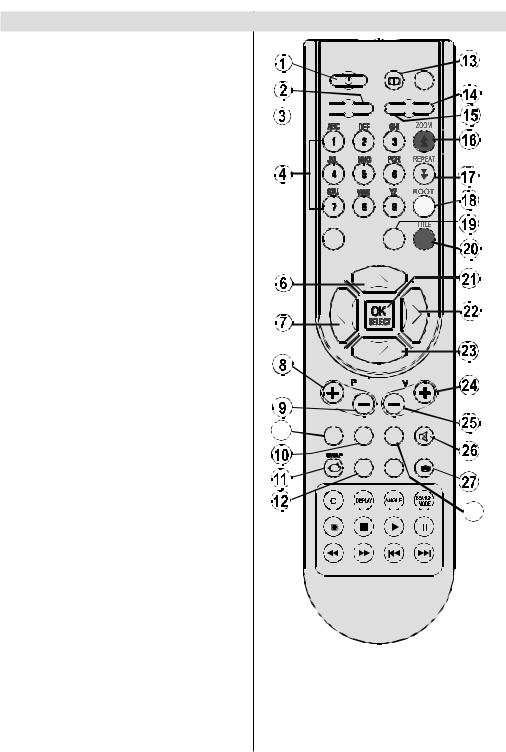
Overview of the Remote Control
1.Standby
2.Image size
3.Sleep timer
4.Numeric buttons
5.Return / TXT Index
6.Cursor up / TXT up page
7.Cursor left
8.Programme up
9.Programme down
10.Mono-Stereo / Dual I-II
11.Swap
12.Electronic programme guide (in DTV mode)
13.Info / TXT reveal
14.Picture mode selection
15.Source selection
16.Red / Sound / Page up (in DTV mode)
17.Green / Picture / Page down (in DTV mode)
18.Yellow / Feature / Current language (in DTV mode) (*)
19.Menu
20.Blue / Install
21.OK / Select / TXT Hold
22.Cursor right / TXT Subpage
23.Cursor down / TXT Downpage
24.Volume up
25.Volume down
26.Mute
27.Teletext / Mix
28.Subtitle (in DTV mode) / TXT Subtitle
29.FAV (Favourite Selection)(in DTV mode)
(*) Only available for EU country options.
Note: Buttons that are not indicated with a number on the remote control illustration are not functional in TV mode.
INFO

 SLEEP
SLEEP 


 SCREEN SOURCE
SCREEN SOURCE


 PRESETS
PRESETS
 RETURN
RETURN  MENU
MENU
29 |
FAV LANG. SUBTITLE |
EPG  /
/
28
English - 6 -

LCD TV and Operating Buttons
FRONT VIEW

 P/CH
P/CH TV/AV
TV/AV
MENU

1.Standby button
2.TV/AV button
3.Programme Up/ Down buttons
4.Volume Up/Down buttons
Note: Press V+/V- buttons at the same time to view main menu.
REAR VIEW
English - 7 -

Viewing the ConnectionsBack Connectors
1.SCART socket inputs or outputs for external devices.
Connect the SCART cable between SCART socket on TV and SCART socket on your external device (such as a decoder, a VCR or a DVD player).
Note: If an external device is connected via the SCART socket, the TV will automatically switch to AV mode.
2.Component Video Inputs (YpBPr) are used for connecting component video.
You can connect the component video and audio sockets with a device that has component output. Connect the component video cables between the COMPONENT VIDEO INPUTS on on the TV and the component video outputs of your device. While connecting, be sure that the letters on your TV, “Y”, “Pb”, “Pr” correspond with your device’s connectors.
3.PC/YPbPr Audio Inputs are used for connecting audio signals of a PC or a device that connects to the TV via YPbPr.
Connect the PC audio cable between the AUDIO INPUTS on the TV and audio output of your PC to enable PC audio.
Connect the audio cable between AUDIO INPUTS on the TV and audio outputs of your device to enable component audio.
4.S/PDIF Out outputs digital audio signals of the currently watched source.
Use an S/PDIF coaxial cable to transfer audio signals to a device that has S/PDIF input.
You should also set SPDIF Out option in the Sound Menu as On.
5.RF Input connects to an antenna or a cable.
Note that if you use a decoder or a media recorder, you should connect the aerial cable through the device to the television with an appropriate antenna cable, as shown in the
English - 8 -
illustrationin the following pages.
6.Audio Line Outs output audio signals to an external device such as an optional sound system.
To connect the external speakers to your TV, use AUDIO LINE OUTS of the TV with an audio cable. Note: Line out feature cannot be used while in HDMI source. You can use SPDIF instead.
7.PC Input is for connecting a personal computer to the TV set.
Connect the PC cable between the PC INPUT on the TV and the PC output on your PC.
8.HDMI 1 : HDMI input
HDMI Input is for connecting a device that has an HDMI socket.
Your LCD Television is capable of displaying High Definition pictures from devices such as a High Definition Satellite Receiver or DVD Player. These devices must be connected via the HDMI sockets or Component Socket. These sockets can accept either 480i, 480p, 576p, 576i, 720p, 1080i, 1080p signals. No sound connection is needed for an HDMI to HDMI connection.
When you use the wall mount kit (optional) with the LCD TV, we would definitely recommend to plug all your cables into the back of the LCD before mounting to the wall.
English - 9 -
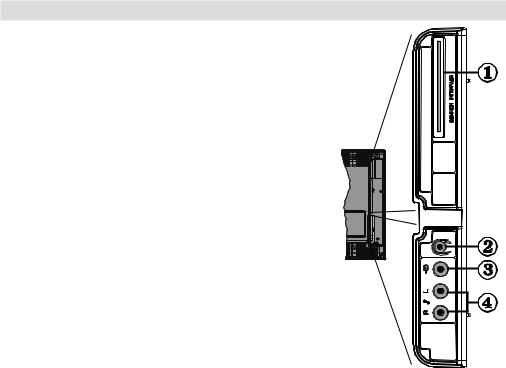
Viewing the Connections - Side Connectors
1. CI Slot is used for inserting a CI card. A CI card allows you to view all the channels that you subscribe to. For more information, see “Conditional Access” section.
2. Headphone jack is used for connecting an external headphone to the system. Connect to the HEADPHONE
jack to listen to the TV from headphones (optional).
3. Video Input is used for connecting video signals of external devices.Connect the video cable between the VIDEO IN socket on the TV and the VIDEO OUT jack on your device.
4. Audio Inputs are used for connecting audio signals of external devices. Connect the audio cable between the
AUDIO INPUTS on the TV and the AUDIO OUTPUT jacks
on your device.
Note: If you connect a device to the TV via the VIDEO INPUT, you should also connect your device with an audio cable to the AUDIO INPUTS of the TV to enable audio.
English - 10 -
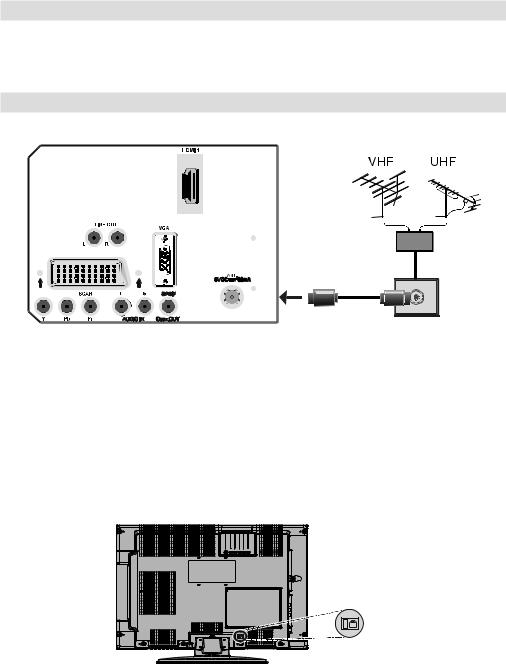
Power Connection
IMPORTANT: The TV set is designed to operate on 220-240V AC, 50 Hz.
•After unpacking, allow the TV set to reach the ambient room temperature before you connect the set to the mains.
•Plug the power cable to the mains socket outlet.
Aerial Connection
• Connect the aerial or cable TV plug to the AERIAL INPUT socket located at the rear of the TV.
REAR VIEW
Anti-theft Protection
Your Tv has an anti-theft lock hole for theft protection.
You can use an optional lock to physically fix the TV when using in a public place or at home.
The anti-theft lock should be purchased separately if desired. The locking method might be different depending on the type of the lock purchased. Please refer to the lock’s instruction manual for proper use.
K
Anti-theft lock hole
English - 11 -

Connecting the LCD TV to a PC
For displaying your computer’s screen image on your LCD TV, you can connect your computer to the TV set.
•Power off both computer and display before making any connections.
•Use 15-pin D-sub display cable to connect a PC to the LCD TV.
•When the connection is made, switch to PC source. See “Input selection” section.
•Set the resolution that suits your viewing requirements. Resolution information can be found in the appendix parts.
REAR VIEW
Audio |
PC Input |
|
Inputs |
||
|
||
PC audio cable |
PC RGB cable |
|
(not supplied) |
(not supplied) |
|
toAUDIO INPUTS |
to PC input |
|
on the TV |
|
English - 12 -
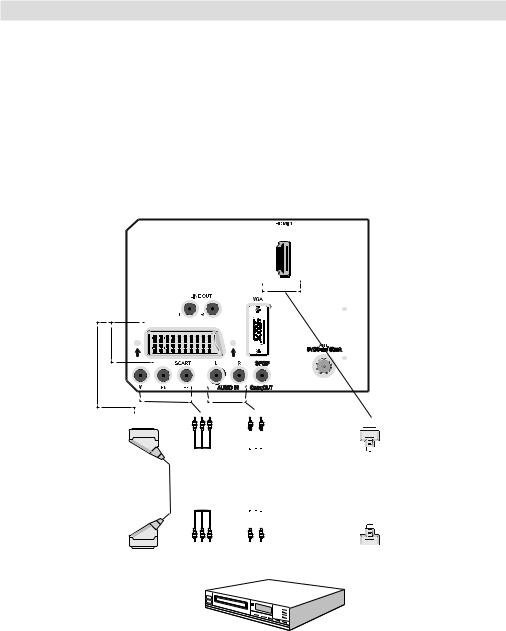
Connecting to a DVD Player
If you want to connect a DVD player to your LCD TV, you can use connectors of the TV set. DVD players may have different connectors. Please refer to your DVD player’s instruction book for additional information. Power off both the TV and the device before making any connections.
Note: Cables shown in the illustration are not supplied.
•If your DVD player has an HDMI socket, you can connect via HDMI. When you connect to DVD player as illustrated below, switch to HDMI source. See, “Input Selection” section.
•Most DVD players are connected through COMPONENT SOCKETS. Use a component video cable to connect video input. For enabling audio, use a component audio cable as illustrated below. When the connection is made, switch to YPbPr source. See, “Input selection” section.
•You may also connect through the SCART socket. Use a SCART cable as shown below.
Note: These three methods of connection perform the same function but in different levels of quality. It is not necessary to connect by all three methods.
|
|
|
|
|
|
|
|
|
|
|
|
|
|
|
|
|
|
|
|
|
|
|
|
|
|
|
|
|
|
|
|
|
|
|
|
|
|
|
|
|
|
|
|
|
|
|
|
|
|
|
|
|
|
|
|
|
|
|
|
|
|
|
|
|
|
|
|
|
|
|
|
|
|
|
|
|
|
|
|
|
|
|
|
|
|
|
|
|
|
|
|
|
|
|
|
|
|
|
|
|
|
|
|
|
|
|
|
|
|
|
|
|
|
|
|
|
|
|
|
|
|
|
|
|
|
|
|
|
|
|
|
|
|
|
|
|
|
|
|
|
|
|
|
|
|
|
|
|
|
|
|
|
|
|
|
Component |
Component |
|
|
||||||||
Scart socket |
video |
audio |
HDMI |
||||||||||
inputs |
inputs |
||||||||||||
|
|
input |
|||||||||||
|
|
|
|
|
|
|
|
|
|
|
|||
DVD Player
REAR VIEW
English - 13 -

Using Side AV Connectors
You can connect a range of optional equipment to your LCD TV. Possible connections are shown below. Note that cables shown in the illustration are not supplied.
•For connecting a camcorder, connect to the VIDEO IN socket and the AUDIO SOCKETS. Do not connect the camcoder to VIDEO IN socket at the same time since it can cause noise in the picture. For selecting the related source, see the section “Input selection” in the following parts.
•To listen the TV sound from headphones, connect to the HEADPHONE jack of theTV.
Headphone
Camcorder
SIDE VIEW
English - 14 -

Using Other Connectors
You can connect a range of optional equipment to your LCD TV. Possible connections are shown below. Note that cables shown in the illustration are not supplied.
•To connect external speakers, use an audio cable. Do not reverse the AUDIO LEFT and AUDIO RIGHT jacks. Turn on the LCD TV and external speaker set after all connections are made. Refer to your speaker set’s manual for further queries.
•For connecting a to a device that has SPDIF support, use an appropriate SPDIF cable to enable sound connection. You should also set SPDIF Out option in the Sound menu as On.
External Speakers
A device that supports SPDIF signal.
REAR VIEW
English - 15 -

Connecting Other Equipment via Scart
Most devices support SCART connection. You can connect a; DVD recorder, a VCR or a decoder to your LCD TV by using the SCART socket. Note that cables shown in the illustration are not supplied.
Power off both the TV and the devices before making any connections. For more information, refer to your device’s own instruction book.
REAR VIEW
Scart socket
DVD Recorder |
Video Recorder |
Decoder |
English - 16 -

Inserting Batteries in the
Remote Control Handset
•Remove the battery cover located on the back of the handset by gently pulling backwards from the indicated part.
•Insert two AAA/R3 or equivalent type batteries inside. Place the batteries in the right directions
and replace the |
. |
Note: Remove the battery from remote control handset when it is not to be used for a long period. Otherwise it can be damaged due to any leakage of batteries.
Operating Range for the
Remote Control
•Point the top of the remote control toward the LCD TV’s remote sensor LED while pressing a button.
30 30
30
INFO 
 SLEEP
SLEEP 


 SCREEN SOURCE
SCREEN SOURCE


 PRESETS
PRESETS
RETURN  MENU
MENU
FAV |
LANG. |
SUBTITLE |
EPG  /
/
Remote range is approximately 7m/23ft.
Switching the TV On/Off
To Switch the TV On
•Connect the power cord to the 220-240V AC 50 Hz.
•Press STANDBY switch. Then the standby LED lights up.
•To switch on the TV from standby mode either:
•Press the “ ” button, P+ / P- or a numeric button on the remote control.
” button, P+ / P- or a numeric button on the remote control.
•Press the -P/CH or P/CH+ button on the TV. The TV will then switch on.
Note: If you switch on your TV via PROGRAMME
UP/DOWN buttons on the remote control or on the
TV set, the programme that you were watching last will be reselected.
By either method the TV will switch on.
To Switch the TV Off
•Press the “ ” button on the remote control or press the STANDBY switch, so the TV will switch to standby mode.
” button on the remote control or press the STANDBY switch, so the TV will switch to standby mode.
•To power down the TV completely, unplug the power cord from the mains socket.
Note: When the TV is switched to standby mode, standby LED can blink to indicate that features such as Standby Search, Over Air Download or Timer is active.
Input Selection
Once you have connected external systems to your TV, you can switch to different input sources.
•Press SOURCE button on your remote control for directly changing sources.
or,
•Select “Source” option from the main menu by using “ ” or “
” or “ ” button. Use then “
” button. Use then “ ” or “
” or “ ” button to highlight an input and press “
” button to highlight an input and press “ ” button to select.
” button to select.
Note: You can mark desired source options by
pressing the OK button. Therefore, when SOURCE button is pressed, only the marked source options will be available (except for the TV source).
English - 17 -

Basic Operations
You can operate your TV using both the remote control and onset buttons.
Operation with the Buttons on the TV
Volume Setting
•Press “
 ” button to decrease volume or
” button to decrease volume or 
 button to increase volume, so a volume level scale (slider) will be displayed on the screen.
button to increase volume, so a volume level scale (slider) will be displayed on the screen.
Programme Selection
• Press “P/CH +” button to select the next programme or “P/CH -” button to select the previous programme.
Viewing Main Menu
•Note: Press V+/V- buttons at the same time to view main menu. In the Main menu select submenu using “P/CH -” or “P/CH +” buttons and enter the sub-menu using “
 ” or “
” or “
 ” buttons. To learn the usage of the menus, refer to the menu system sections.
” buttons. To learn the usage of the menus, refer to the menu system sections.
AV Mode
•Press the “TV/AV” button in the control panel on the TV to switch between AV modes.
Operation with the Remote Control
•The remote control of your TV is designed to control all the functions of the model you selected. The functions will be described in accordance with the menu system of your TV.
•Functions of the menu system are described in the following sections.
Volume Setting
•Press V+ button to increase the volume. Press V- button to decrease the volume. A volume
level scale (slider) will be displayed on the screen.
Programme Selection (Previous or Next Programme)
•Press “P -” button to select the previous programme.
•Press “P +” button to select the next programme.
Programme Selection (Direct Access)
•Press numeric buttons on the remote control to select programmes between 0 and 9. The TV will switch to the selected programme. To select programmes between 10 - 299 (for IDTV) or 10-199 (for analogue), press the numeric buttons consecutively (e.g. for programme 27, first press 2 and then 7). When the pressing time is due for the second numeric button, only the first digit programme will be displayed. The limit of the delay time is 3 seconds.
•Press directly the programme number to reselect single digit programmes.
English - 18 -

Initial Settings
When the TV set is operated for the first time, the IDTV turns on first.
Because this is the first time the TV is used, there are no channels stored in the memory.
When the TV is turned on for the first time, the menu for the language selection appears on the screen. The message “Welcome please select your language!” is displayed in all language options sequentially in the OSD.
By pressing the “ ” or “
” or “ ” buttons highlight the language you want to set and press OK button. After then, “First time installation” OSD will appear on the screen. By pressing “
” buttons highlight the language you want to set and press OK button. After then, “First time installation” OSD will appear on the screen. By pressing “ ” or “
” or “ ” buttons, select the country you want to set and press OK button (* for EU countries).
” buttons, select the country you want to set and press OK button (* for EU countries).
Note: Country selection OSD will not be available for UK.
After then, the active antenna selection OSD appears on the screen:
By pressing “ ” or “
” or “ ” buttons, set active antenna mode as on or off.
” buttons, set active antenna mode as on or off.
If an active antenna is connected to your TV, you can select this option as On. Antenna power should be “Off” when standard antenna is used instead of the active antenna. See Configuration Menu in the following sections for more information.
Press OK button on the remote control to continue and the following message will be displayed on the screen:
To start installation process, select “Yes”, to cancel select “No”.
•To select the “Yes” or “No” option, highlight the item by using “ ” or “
” or “ ” buttons and press the OK button.
” buttons and press the OK button.
The IDTV will automatically tune to the UHF or VHF(*) (* for EU countries) transmission
channels, searching for digital terrestrial TV broadcasts and displaying the names of channels found. This process will take about a few minutes.
After Automatic Search is completed, the following message asking for analogue channel search appears on the screen:
To search for analogue channels, select “Yes”. TV switches to the analogue TV mode. The menu below is displayed to search for analogue channels:
Select your Country, Language and Text language by using “ ” or “
” or “ ” and “
” and “ ” or “
” or “ ” buttons. Press OK or RED button to continue. To cancel, press the BLUE button.
” buttons. Press OK or RED button to continue. To cancel, press the BLUE button.
For more information on this process, see “Install Menu” section.
Note: For proper functioning of digital teletext in DTV mode, you should set country as UK in analogue
AUTO PROGRAM (for UK broadcasts only).
Do not turn off the TV while initializing first time installation.
English - 19 -
